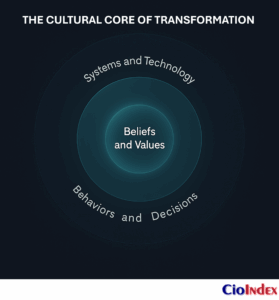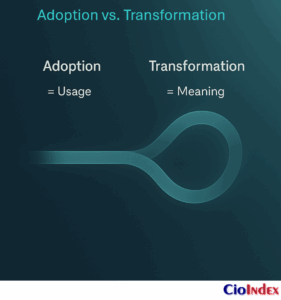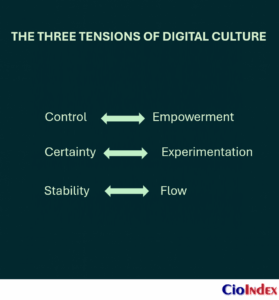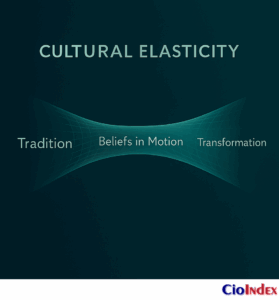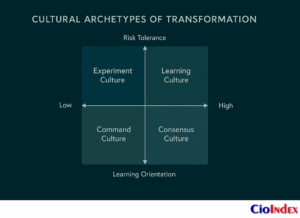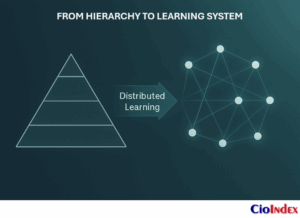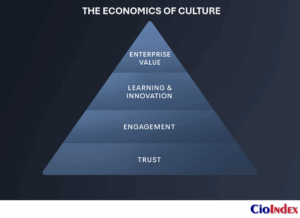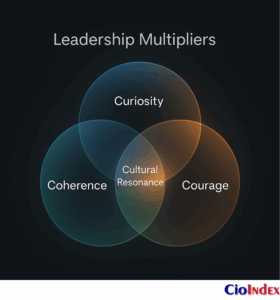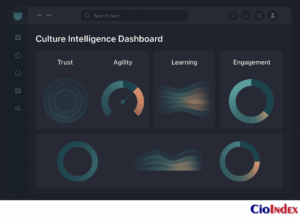Culture: The Unwritten Code of Transformation
Every transformation begins with a shift in perception. Before systems are redesigned or data is centralized, an organization must first confront how it interprets change itself. Technology alters capability; culture alters comprehension. And without comprehension, transformation cannot take root.
Culture defines the boundaries of what an enterprise believes is possible. It is the invisible architecture that shapes how people respond to new information, navigate uncertainty, and decide what progress means. The more digital an organization becomes, the more its cultural foundations are tested—because every new tool quietly asks, can your values keep up?
Most transformation failures are not the result of flawed strategies or broken technologies. They arise when the organization’s underlying belief system cannot absorb the new logic of the digital era. Technology exposes what culture has concealed: a lack of trust, rigidity of thought, or fear of experimentation. These fractures are not visible in code, but they appear immediately in behavior—hesitation, deflection, or silent resistance.
Culture cannot be engineered by mandate or memo. It evolves through patterns of meaning, reinforced daily in how people make decisions, resolve tension, and attribute value. A new platform may automate tasks, but it cannot automate belief. A modern architecture can integrate data, yet it cannot integrate intent. Transformation occurs only when the collective mindset learns to reinterpret both technology and itself.
An organization’s true transformation capacity is measured not by how quickly it implements new tools, but by how willingly it reconsiders its own assumptions. The velocity of change depends on cultural adaptability—the ability to question, reframe, and learn at scale. Culture, in this sense, is not a background condition; it is the medium through which transformation either accelerates or dissolves.
The future of transformation belongs to organizations that treat culture as code—not an obstacle to rewrite, but a living system to evolve.
Most transformation programs still measure success by what is easiest to count: system rollouts, training sessions, and adoption rates. Adoption offers the illusion of progress because it produces visible numbers, not invisible learning. But digital maturity is not a matter of usage; it is a matter of meaning. What organizations call adoption is often only adjustment—a behavioral accommodation to new tools without a corresponding evolution of values.
The Myth of Technology Adoption
The success of digital transformation is often reported in percentages—how many employees have completed training, how many systems have gone live, how many users have logged in. Adoption metrics fill dashboards because they are tangible, quantifiable, and safe. They create the comforting illusion that progress can be tracked by participation alone. Beneath the numbers, however, culture remains unchanged.
Adoption is not transformation. It measures conformity to a tool, not conversion of a mindset. A workforce can be trained to use new software while still operating through old assumptions—hoarding data, avoiding accountability, or treating information as territory rather than insight. What appears to be participation is often performance: people learning to comply with technology rather than to think through it.
This is why so many digital initiatives plateau after their initial rollout. Systems may be deployed successfully, but the behavioral architecture that gives them meaning stays untouched. Collaboration platforms fail to foster collaboration. Data warehouses centralize information without creating shared intelligence. Automation reduces errors while leaving friction intact. The organization upgrades its tools but not its truth.
True transformation begins when technology becomes a mirror, not a mandate—when it reflects the behaviors and belief systems that either sustain or subvert progress. Adoption programs seldom reach that depth because they are designed for convenience, not conviction. They train the hands before they engage the mind. Culture, however, does not change through instruction; it changes through interpretation.
The distinction is subtle but decisive: adoption modifies what people do; culture redefines what people believe. The first delivers short-term compliance; the second builds long-term capability. One installs systems; the other constructs sense-making. Until that distinction becomes explicit, organizations will continue mistaking the appearance of change for its substance.
Transformation is not measured by how many have adopted the tool, but by how many have redefined their work through it.
If adoption reveals how people adjust to technology, culture reveals how they evolve with it. The difference is depth: adoption stops at behavior; culture reshapes belief. To understand why some organizations adapt fluidly while others fracture, we need to look beyond processes and platforms to the underlying system of shared meaning—the logic that governs how people interpret change, tolerate ambiguity, and translate new tools into new ways of working. That logic is what defines a digital culture.
Understanding Digital Culture — Meaning, Elasticity, and Scale
Culture is often described as “how we do things here.” In reality, it is closer to “how we make sense of what we do.”
It is the shared logic that guides behavior when no policy is clear, the invisible consensus about how to act, decide, and learn in moments of uncertainty. Digital transformation challenges that consensus because it alters the conditions under which meaning is made.
Technology changes what people can do; culture determines what they will do with it. As digital systems accelerate information flow and decision cycles, traditional hierarchies and habits of control begin to strain. The same qualities that once ensured stability—clear chains of command, predictable routines, measured approval—become liabilities in environments that demand speed, experimentation, and transparency. Culture, therefore, becomes the true bottleneck or amplifier of digital change.
The Three Tensions of Digital Culture
Every organization navigating transformation experiences three persistent cultural tensions:
- Control vs. Empowerment — The instinct to govern outcomes collides with the need to distribute authority.
- Traditional governance prizes predictability; digital environments reward responsiveness.
- Empowerment does not mean the absence of control—it means control through clarity rather than constraint.
- Certainty vs. Experimentation — The demand for reliable plans conflicts with the necessity of learning through iteration.
- In adaptive cultures, experimentation becomes a form of discovery, not deviation.
- The measure of maturity is how comfortably an organization learns in public.
- Stability vs. Flow — The desire for structural consistency meets the requirement for continuous movement.
- Digital systems evolve faster than organizational identities.
- Cultures that define stability as continuity of purpose rather than constancy of form remain coherent while adapting.
These tensions cannot be eliminated; they must be balanced. The healthiest digital cultures live at the intersection of these opposing forces—structured enough to maintain coherence, fluid enough to evolve.
Cultural Elasticity: The Hidden Variable
The organizations that thrive in transformation are not necessarily the most advanced technologically, but the most elastic culturally. Cultural elasticity is the ability to stretch beliefs and behaviors to accommodate new realities without breaking collective identity. It is what allows a 150-year-old enterprise to adopt new logics without losing its sense of self.
Elastic cultures are defined by three qualities:
- Interpretive Capacity — the ability to extract meaning from novelty rather than react to it.
- Psychological Safety — the confidence to challenge norms without threatening belonging.
- Purpose Coherence — a stable north star that enables flexible navigation.
Elasticity transforms uncertainty from a threat into a learning environment. When beliefs can stretch without tearing, adaptation becomes continuous. When they cannot, transformation hardens into procedure—change reduced to compliance rather than discovery.
Culture at Scale
Global enterprises face a distinct challenge: maintaining shared identity across distributed, hybrid, and multicultural environments. Digital technologies magnify that challenge by connecting people faster than shared meaning can travel. As information spreads instantly, interpretation fragments. The same message, system, or initiative can evoke entirely different responses depending on local context.
Scalable digital cultures solve this not by enforcing uniformity, but by codifying principles that travel while practices adapt. They replace centralized control with coherent intent. The culture becomes fractal—recognizable in every unit, but never identical.
When culture scales in this way, transformation stops being a project and becomes a pattern: a living equilibrium between continuity and change.
To understand how culture expresses itself in practice, we can map its dominant archetypes—the recurring patterns of belief and behavior that shape how organizations respond to transformation itself.
Cultural Archetypes of Transformation
Every organization carries a distinct cultural signature—a pattern of beliefs and behaviors that determines how it responds to change. Some cultures absorb disruption and learn from it; others interpret it as threat and retreat into control. These reactions are not random. They reveal deep-seated assumptions about power, learning, and trust. Understanding those assumptions is the first step toward reshaping them.
Culture behaves like a system of adaptation. When confronted with the new, it expresses its true logic—how it defines authority, handles ambiguity, and measures progress. Across industries and geographies, these logics tend to converge into four dominant archetypes. Each archetype reflects a particular relationship between risk tolerance and learning orientation—the two dimensions that most determine transformation readiness.
The Command Culture
Signature: Hierarchical, risk-averse, and rule-bound.
Behavior: Change is executed through control. Leadership defines, directs, and monitors. Success is compliance with plan.
Result: Transformation is procedural rather than adaptive—delivered on schedule, but rarely internalized.
Risk: Cultural brittleness. When external conditions shift, the system cannot flex.
Command cultures often appear efficient in stable environments because they value discipline and predictability. But in digital contexts, they struggle to metabolize novelty. Information travels upward, not outward. Learning occurs only through permission. Innovation, when it happens, is isolated from decision-making power.
The Consensus Culture
Signature: Cooperative, inclusive, and cautious.
Behavior: Change is discussed until it feels safe. Decisions seek unanimity rather than momentum.
Result: Transformation progresses incrementally, with broad participation but limited velocity.
Risk: Diffused accountability. The desire to maintain harmony dilutes urgency.
Consensus cultures often emerge in organizations proud of their collegial identity. They excel at building buy-in but falter at decisive execution. When disruption accelerates, the cost of alignment becomes delay. By the time everyone agrees, the opportunity has often moved on.
The Experiment Culture
Signature: Curious, action-oriented, and tolerant of failure.
Behavior: Change occurs through trial and feedback. Learning replaces planning as the dominant mode of progress.
Result: Rapid innovation and insight, but uneven scaling.
Risk: Cultural fatigue. Without reflection and coherence, experimentation becomes fragmentation.
Experiment cultures flourish where leadership celebrates discovery and de-stigmatizes failure. They move quickly and learn constantly, but can exhaust themselves if learning is not consolidated into institutional knowledge. Speed without synthesis produces bursts of progress but little permanence.
The Learning Culture
Signature: Reflective, adaptive, and accountable.
Behavior: Change is integrated, not episodic. Learning is built into the operating rhythm.
Result: Transformation becomes continuous and sustainable.
Risk: Complacency of mastery—the illusion that learning itself is enough without external challenge.
Learning cultures convert feedback into foresight. They design rituals of reflection, track lessons as assets, and distribute authority through trust rather than hierarchy. Their strength lies in coherence—the ability to evolve without losing identity. They are not the most radical cultures, but they are the most resilient.
From Archetype to Evolution
These archetypes are not fixed categories; they are evolutionary states. Organizations often move through them as they mature in both mindset and method. The typical path begins with Command, softens into Consensus, experiments toward Experiment, and stabilizes as Learning. Each stage expands the organization’s tolerance for ambiguity and its capacity for shared interpretation.
Transformation maturity, therefore, is not the absence of constraint—it is the presence of conscious adaptation. A culture becomes transformation-ready when learning is no longer an initiative but a reflex.
To evolve from one archetype to another, organizations must rewire their internal mechanisms of learning and reflection—shifting from hierarchy to system, from compliance to connection. That shift begins at the cultural core.
Shifting the Cultural Core — From Hierarchy to Learning Systems
Most organizations begin transformation by reengineering processes; few begin by reengineering how they learn. Hierarchies are built to preserve what is known, not to explore what is possible. They centralize authority to reduce risk, but in doing so, they also centralize learning. Information flows upward, decisions flow downward, and the distance between insight and action grows wider with every layer.
Digital transformation exposes this architecture’s limitations. When information moves faster than hierarchy, the organization’s capacity to learn becomes its real bottleneck. Systems evolve in real time; governance reacts in cycles. The mismatch between technological speed and institutional reflex creates friction that no software can fix. The solution is not flatter structures but learning systems—organizations that distribute learning the way they once distributed control.
The Three Reinforcing Mechanisms of a Learning System
- Psychological Safety — The Permission to Challenge
Cultural evolution begins when people can question without consequence. Psychological safety is not about comfort; it is about candor. It creates an environment where dissent signals engagement, not defiance. When employees can expose weak assumptions early, the organization saves itself from expensive corrections later. - Transparent Information Flows — The End of Gatekeeping
Transparency transforms control into clarity. When data is open, interpretation becomes collective. Decisions improve because they emerge from multiple vantage points, not privileged silos. Transparency also dismantles internal politics—the invisible tax on collaboration that erodes trust. - Feedback Rituals — The Rhythm of Reflection
Learning cultures do not rely on ad-hoc feedback; they design it as a system. Postmortems, retrospectives, and open debriefs turn mistakes into institutional memory. Reflection becomes a structural advantage. Feedback is not a judgment but a joint inquiry into how the organization learns.
These three mechanisms create a continuous cultural loop: Transparency → Experimentation → Reflection → Reinforcement, cycling back to greater transparency. The loop is self-healing—each round makes the organization more adaptive, less dependent on hierarchy, and more responsive to change.
Microcultures: Cultural Accelerators Within Bureaucracy
Large organizations rarely transform as a whole; they evolve through microcultures. These are localized pockets—teams, departments, or innovation hubs—that embody the future the enterprise aspires to reach. Within them, experimentation is safer, learning cycles are faster, and behaviors spread organically through influence rather than decree. Over time, microcultures act as cultural accelerators, creating proof that new norms can coexist with legacy systems.
Transformation leaders must learn to govern through microcultures: nurturing them, connecting them, and protecting them from the gravitational pull of bureaucracy. When networked intentionally, they form a distributed learning ecosystem—each node amplifying the organization’s overall intelligence.
From Command to Connection
Moving from hierarchy to learning does not mean abandoning structure; it means redesigning it for flow. Control is replaced by context.
Authority shifts from titles to trust. Progress is measured not by compliance to plan, but by the speed at which insight becomes action.
This shift redefines what leadership means. The leader’s role is no longer to be the node of certainty but the architect of connection—the one who ensures the system keeps learning.
Transformation at this level is cultural engineering in its purest sense: the deliberate design of conditions under which learning becomes the default response to change.
Once learning becomes the organizing principle, culture begins to generate measurable value of its own. What was once considered intangible—beliefs, trust, and engagement—turns into a form of capital. This is where the economics of culture emerge.
The Economics of Culture
Every transformation ultimately confronts a financial question: what does culture cost, and what does it return? For years, culture was treated as an intangible—valuable but unquantifiable, important but peripheral. That perception allowed it to escape accountability. In reality, culture has always been an economic variable; its effects simply compound invisibly until they appear as attrition, inefficiency, or lost innovation.
The Hidden Cost of Cultural Misalignment
When culture and strategy diverge, organizations bleed energy. Projects stall not for lack of talent but because belief systems collide. Employees disengage when they cannot see meaning in metrics. Leaders spend more time enforcing alignment than inspiring it. These costs rarely appear in budgets, yet they are visible in outcomes: missed timelines, duplicated work, and diminished creativity.
Cultural drag also compounds. Every act of disengagement or unspoken hesitation slows execution. Over time, that friction translates into measurable financial waste. A global study by Gallup estimated that disengaged employees cost organizations nearly 9% of total revenue productivity—an invisible tax on transformation.
Digital initiatives amplify this risk because they expose behavior at scale. A single cultural bottleneck—fear of transparency, territorial decision-making, or lack of trust—can cascade across systems, eroding both speed and quality. The price of cultural inertia is paid in momentum lost.
The ROI of Cultural Alignment
When culture and strategy align, the financial effects are equally pronounced. High-trust organizations consistently outperform peers in profitability, innovation throughput, and retention. Cultural alignment accelerates time-to-value by reducing the cost of coordination—the hidden overhead of bureaucracy.
The economics of culture operate through four reinforcing levers:
- Engagement → Productivity
Purpose-driven employees expend discretionary effort; their output exceeds contractual expectations. - Trust → Speed
In cultures of psychological safety, fewer cycles are spent on verification and approval. Decisions move closer to real time. - Learning → Innovation
Reflection and feedback loops turn error into asset, reducing waste and increasing discovery yield. - Coherence → Retention
Cultural clarity sustains belonging, reducing churn and the cost of reacquiring lost knowledge.
When these levers interact, culture transforms from a cost center into a value multiplier. What once seemed intangible becomes measurable through velocity, engagement, and innovation metrics—all leading indicators of financial performance.
Culture as Capital
Cultural capital is the organization’s capacity to generate trust, coordination, and meaning faster than competitors can replicate them. Unlike financial capital, it does not depreciate with use; it compounds. Every act of transparency builds more trust, every moment of shared reflection creates institutional memory. Over time, the organization develops a self-reinforcing advantage: lower transaction costs, higher adaptability, and greater resilience.
Boards and CFOs increasingly recognize culture as infrastructure—the invisible platform that enables every other form of capital to perform. Treating culture as an investment, not an expense, reframes transformation economics entirely. It shifts the question from “How do we justify culture?” to “How much value are we losing without it?”
The Governance of Intangibles
Culture becomes economically relevant only when it is governed. Boards must begin tracking culture as a performance system—using both qualitative signals (trust, purpose coherence) and quantitative indicators (turnover, collaboration density, learning velocity). This approach embeds culture into accountability cycles, making it a strategic asset under active management rather than an abstract principle left to HR.
The return on culture is not measured quarterly; it accrues through momentum—the ability to move in one direction with shared belief and minimal friction.
Once culture is recognized as capital, leadership becomes the mechanism that compounds it. The next question is how leaders translate conviction into behavior—how their actions multiply or diminish the culture they inherit.
Leadership and the Multipliers of Cultural Change
Culture does not change because leaders announce it; it changes because they embody it. Every system of belief within an organization is modeled somewhere in its leadership behavior. The meetings they convene, the questions they ask, and the silences they permit transmit the real values that people learn to follow. A single incongruent act from leadership can undo months of cultural communication.
Digital transformation shifts leadership from setting direction to shaping interpretation. As technology flattens access to information, authority depends less on control of knowledge and more on curation of meaning — helping people understand what matters, why it matters, and how to act on it. Leaders no longer compete on answers but on their capacity to frame better questions.
The Three Leadership Multipliers
Effective leaders expand culture through behavior. They multiply trust, coherence, and courage by modeling them publicly until they become norms.
Three qualities, when consistently demonstrated, accelerate this multiplication effect.
Curiosity — The Catalyst of Discovery
Curiosity is the discipline of seeking what you do not yet understand. It replaces certainty as the foundation of credibility. Curious leaders approach ambiguity as an opportunity to learn, not a problem to solve. They ask questions that reveal systems, not symptoms—questions that make others think differently rather than prove them wrong. Curiosity converts change from threat to exploration; it sets the emotional tone for innovation.
Coherence — The Architecture of Trust
Coherence is the alignment between what leaders say and what they design. When leadership stories match organizational structures, trust follows naturally. A leader who preaches collaboration but maintains information silos teaches conformity, not culture. Coherence requires the courage to realign incentives, metrics, and governance with stated values—even when doing so slows short-term gains. It is the difference between rhetorical leadership and structural integrity.
Courage — The Proof of Conviction
Courage is not aggression; it is consistency under pressure. It is the decision to uphold values when circumstances tempt compromise. Courage often means allowing experiments to fail publicly, admitting what did not work, or defending the long view against quarterly impatience. Courageous leaders transform fear into focus. Their calm under uncertainty gives the organization permission to continue learning.
The Geometry of Leadership Influence
Curiosity, Coherence, and Courage rarely act in isolation. They create a field of influence—a kind of cultural gravity that draws others toward similar behavior. Curiosity fuels exploration, Coherence sustains trust, and Courage maintains direction.
When one is missing, momentum falters: curiosity without coherence creates chaos; coherence without courage breeds stagnation; courage without curiosity hardens into ideology. Balance among the three generates cultural resilience.
The Language of Leadership
Leaders also shape culture through narrative. Stories define what the organization remembers, celebrates, and fears. When used intentionally, storytelling becomes a governance tool—a means of encoding meaning into the collective mind. The most powerful cultural stories are not about victory but about learning: moments when a team faced uncertainty, reflected honestly, and emerged stronger. Such stories create identity continuity through change, reminding people that adaptation is part of who they are.
The emotional intelligence behind this storytelling is not ornamental—it is operational. Empathy, purpose, and connection are the mechanisms by which leaders turn information into understanding. Emotional intelligence ensures that culture remains human even as systems become algorithmic.
Leadership as Cultural Infrastructure
Leadership does not sit above culture; it is embedded within it. Leaders are not the architects of culture but its stewards—responsible for ensuring that what they reinforce reflects what they believe. Every hiring decision, performance review, and recognition ritual becomes a signal. Over time, those signals either multiply coherence or erode it.
The real measure of leadership in digital transformation is not control over outcomes, but influence over interpretation. Technology changes processes; leadership changes possibility.
To sustain that possibility, organizations must learn to observe and manage culture with the same rigor they apply to financial or operational performance. Culture may be intangible, but it leaves measurable traces. The next frontier is learning how to read them.
Measuring and Sustaining Cultural Change
Culture often resists measurement because it hides in plain sight. It lives in patterns of interaction, not in formal documents. Surveys capture sentiment, but not behavior; metrics reveal activity, but not interpretation. The challenge is to see culture as a living system—something that leaves traces in how people collaborate, decide, and learn.
Digital transformation makes those traces visible. The same technologies that accelerate communication also expose how communication actually happens. Collaboration platforms, project tools, and digital workflows generate behavioral data that can reveal how trust, learning, and engagement evolve over time. When interpreted wisely, these signals provide a mirror of organizational health.
From Anecdote to Evidence
Traditional approaches to cultural assessment relied on perception — periodic surveys, engagement scores, or consultant-led diagnostics. These remain valuable but incomplete. The next step is to integrate qualitative insight with real-time behavioral analytics, creating a more dynamic understanding of culture in motion.
Modern organizations now measure culture through both qualitative and quantitative lenses:
- Qualitative Indicators:
Narrative coherence, language patterns, and shared metaphors.
How people describe their work reveals how they interpret purpose. - Quantitative Indicators:
Collaboration density, learning velocity, decision-cycle time, and cross-team connectivity.
These patterns show whether the organization’s reflexes are adaptive or defensive.
They transform culture from a static perception to a system of data—a network of meaning that can be observed, mapped, and improved.
Culture Analytics: Seeing the Invisible
Advances in analytics now allow organizations to visualize the evolution of their cultures. Network analysis can identify central connectors and silent bottlenecks. Language processing can detect shifts in tone that signal rising stress or growing trust. Pulse data from digital tools can highlight whether teams are converging around shared goals or fragmenting into silos.
Used responsibly, these insights turn what was once intangible into an evidence base for leadership.
The goal is not surveillance but sense-making — to understand how the culture learns, collaborates, and adapts. When culture becomes observable, it becomes governable.
Embedding Culture in Governance
Measurement without reinforcement leads to decay. For culture to sustain itself, its signals must feed back into the organization’s decision cycles. Boards and executives should review cultural indicators alongside financial and operational metrics. Transformation governance meetings can include “learning health checks” that track reflection rituals, collaboration rates, and employee voice participation.
Embedding culture in governance does more than institutionalize awareness — it normalizes accountability.
It shifts culture from a side conversation to a management discipline. When leadership tracks how the organization learns, it communicates that learning is not an activity — it is the business model.
From Measurement to Momentum
Cultural data has meaning only when it produces motion. The purpose of measurement is not to describe the culture but to guide its evolution. Continuous monitoring enables early intervention, celebrating adaptive behaviors and correcting drift before it calcifies into dysfunction. The focus is not perfection but responsiveness — the ability to sense and adjust.
Culture matures when it develops its own feedback loop: aware of itself, accountable to itself, and capable of renewal without waiting for crisis.
As culture becomes measurable and self-correcting, its governance rises to the boardroom. At that level, the question is no longer whether culture supports strategy—but whether strategy aligns with culture.
Implications for CIOs and Boards — Culture as Infrastructure
Technology may enable transformation, but culture determines whether it endures. As digital systems become the arteries of enterprise operations, the beliefs that govern how those systems are used become a form of infrastructure in their own right.
Culture shapes the flow of trust, the velocity of decisions, and the interpretation of risk. It defines the difference between a digital enterprise that reacts to disruption and one that learns through it.
The CIO as Cultural Translator
The modern CIO now operates as both technologist and anthropologist. Their mandate extends beyond system reliability into sense-making—translating the logic of technology into the language of people, and vice versa. Every digital initiative carries a cultural dimension: it redefines ownership, collaboration, and accountability.
When CIOs approach transformation through a purely technical lens, they address symptoms. When they address the cultural layer—the stories, norms, and incentives that determine how technology is used—they change the system itself.
This translation role demands fluency in both architectures: the technical and the human. One defines what the enterprise can do; the other determines what it will choose to do. Bridging them is now the CIO’s most strategic contribution.
The Board’s Role in Cultural Stewardship
For boards, culture has long been a topic acknowledged but rarely governed. That distance is narrowing. Cultural misalignment is now recognized as a leading indicator of strategic failure—whether through ethics breaches, failed integrations, or stalled transformation. Boards cannot delegate culture; they must measure and monitor it with the same rigor applied to capital and risk.
Cultural governance requires three practical shifts:
- Integration of Metrics — Review cultural indicators—trust, learning velocity, engagement—alongside financial and operational KPIs.
- Incentive Alignment — Ensure executive rewards reinforce collaboration, adaptability, and transparency, not territorial performance.
- Narrative Oversight — Track how leadership stories align with enterprise values. Disconnection here signals cultural drift before it manifests as dysfunction.
When culture enters the governance agenda, transformation gains endurance. It no longer depends on the enthusiasm of a few executives; it becomes institutional muscle.
Culture as Infrastructure
Culture functions as the invisible infrastructure of transformation—the layer that connects technology, information, and intelligence.
It stabilizes systems during disruption and accelerates learning in recovery. Unlike physical infrastructure, which depreciates over time, cultural infrastructure strengthens through use. Each act of transparency, trust, or reflection adds to its integrity.
From Oversight to Ownership
Boards and CIOs share an emerging responsibility: to own culture as a performance asset. That ownership does not mean control—it means accountability for the conditions that allow learning, trust, and adaptability to thrive. When governance integrates culture into its design, the enterprise moves from managing transformation to mastering it.
The durability of any transformation lies not in its systems but in the culture that sustains them.
Technology delivers capability; culture delivers continuity.
The ultimate test of cultural maturity is not alignment, but flow—the ability of an organization to evolve continuously without losing coherence. This is where transformation becomes self-sustaining.
From Culture Fit to Culture Flow
Every era of transformation begins with the same question: how should we change? The more difficult question is how will we continue to? Technology evolves in cycles; culture evolves in currents. The organizations that endure are those that learn to move with those currents—shaping them without freezing them into form.
The language of “culture fit” belongs to a world that assumed stability. Fit implied permanence, the comfort of sameness, the safety of belonging to something fixed.
But digital transformation rewards motion, not maintenance. The real work is not to preserve a culture that fits, but to design one that flows — a system of beliefs, values, and behaviors capable of absorbing new tools, new ideas, and new people without losing its coherence.
Culture flow is not fluidity without purpose; it is continuity without rigidity. It allows the enterprise to remain recognizably itself while continuously reinventing its expression.
When that state is reached, culture no longer lags behind strategy—it becomes the medium through which strategy evolves. Learning, adaptation, and reflection stop being responses to change and start becoming reflexes of identity.
This is what it means to complete the cultural dimension of digital transformation: not to create a “digital culture,” but to cultivate a culture that can remain human through constant digital reinvention. Such cultures treat learning as infrastructure, trust as currency, and change as a shared act of understanding.
When technology changes faster than people, culture becomes the medium of survival. When culture learns to flow, transformation never has to start again.
